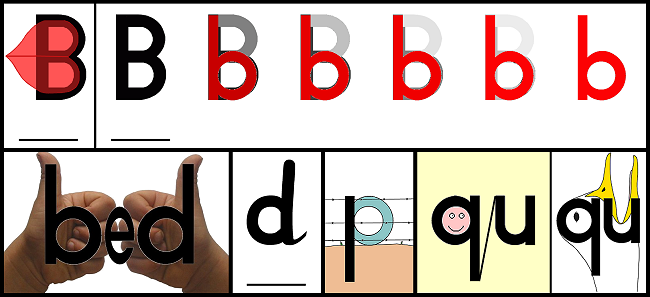bdpq confusion, or more often confusing b/d/p, or just b/d, is a very common problem for many children. Here are some ideas that can help.
It is important, from the beginning, for children to learn to write each letter with the correct starting point and directions. This helps cement the association between the sound of the letter and its orientation and helps prevent difficulties with b/d/p/q confusion, in both reading and writing, from becoming entrenched. Imagine the letters made with balls and sticks. When reading or writing “a”, “b”, “d”, “g”, “p” or “q” (going from left to right):
- Do you meet the “ball” or the “stick” first? Draw that first.
- Start the circle at the join and go up. If the circle is first, go anticlockwise (“back and round”); if it is second, go clockwise (“up and round”).
- Always start the stroke at the top (“top to bottom”).
Once a firm foundation of starting points and directions has been established, “ball and stick” writing can be easily adapted to whatever beginner handwriting style is taught in schools in your area. It is easy to learn to add the slope, with or without a kick, as the whole class learns. However, if “dyslexic” children experience difficulty with “joined” writing, let them continue with a style with which they are comfortable. To help with b/d confusion try
- Put your lips together to say /b/. If you look from the side, the capital “B” looks like your lips.
- Write a capital “B”, then rub out the top curve.
- The letter “d” can have a tail to join it to the next letter. Like a dog that has a tail.
- Make a bed with your hands.
Remember the rhymes for “p” and “q”.
- “p” is for post dug deep in the ground.The post must come first or your fence will fall down.”
- Try pretending to “dig down into the ground, then bring the dirt up and over, then bring your spade round.”
- “q” is quite quiet, its friend is “u”.But they’re not quiet at all when they quack like a duck.”
- “q” and “u” like to hold hands because they are friends.
See Videos to Teach Reading Level 4_3 for more on “q”, “qu” and p/q confusion, and Videos to Teach Reading Level 3_2 for help with b/d.
Click on the bottom right hand corner of each video to see it full screen. If you have trouble seeing the videos try b, d, p, q
Thanks to Zoodoo (Trevor Cuttriss, owner/manager), Richmond, Tasmania for permission to film the deer and pigs.
To see the other videos go to Videos for Children
Print the page bdpq help. Either use it as it is, or cut out and use the memory aids that your child finds most helpful to help tackle bdpq confusion.





{ 2 comments… read them below or add one }
I am a Second Grade teacher for an International school ,overseas.
I am interested in dyslexic and dysgraphic problems,because I am always ready to learn how to help my kids to overcome their difficulties.Their school life is sometime pretty sad and I don’t want to see anymore tears in their eyes!
Regards
I hope my suggestions are helpful.
Jeanne